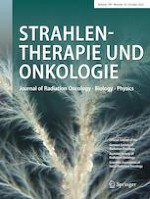Erschienen in:

31.05.2023 | Original Article
Predictors of toxicity after curative reirradiation with intensity modulated radiotherapy or proton therapy for recurrent head and neck carcinoma: new dose constraints for pharyngeal constrictors muscles and oral cavity
verfasst von:
Arnaud Beddok, MD, Xavier Maynadier, MD, Samar Krhili, MD, Catherine Ala Eddine, MD, Laurence Champion, MD, Anne Chilles, MD, Farid Goudjil, MSc, Sofia Zefkili, PhD, Malika Amessis, MSc, Olivier Choussy, MD PhD, Christophe Le Tourneau, MD PhD, Irene Buvat, PhD, Gilles Créhange, MD PhD, Matthieu Carton, MD PhD, Valentin Calugaru, MD PhD
Erschienen in:
Strahlentherapie und Onkologie
|
Ausgabe 10/2023
Einloggen, um Zugang zu erhalten
Abstract
Background
Our study aims to identify predictive factors of moderate to severe (grade ≥ 2) late toxicity after reirradiation (reRT) of recurrent head and neck carcinoma (HNC) and explore the correlations between dose organs at risk (OAR) and grade ≥ 2 toxicity.
Material and methods
Between 09/2007 and 09/2019, 55 patients were re-irradiated with IMRT or proton therapy with curative intent for advanced HNC. Our study included all patients for whom data from the first and second irradiations were available. Co-variables, including interval to reRT, size of re-irradiated PTV, and dose to OAR, were analyzed as potential predictors for developing moderate to severe long-term toxicity with death as a competing risk. Receiver-operator characteristics (ROC) analysis assessed the association between dose/volume parameters and the risk of toxicity.
Results
Twenty-three patients participated in our study. After a median follow-up of 41 months, 65% of the patients experienced grade ≥ 2 late toxicity. The average dose to pharyngeal constrictor muscles (PCM) at the time of reRT showed an association with the risk of grade ≥ 2 dysphagia: AUC = 0.78 (95% CI: 0.53–1), optimal cut-off value = 36.7 Gy (sensitivity 62%/specificity 100%). The average dose to the oral cavity at the time of reRT showed an association with the risk of grade ≥ 2 dysgeusia: AUC = 0.96 (0.89–1), optimal cut-off value = 20.5 Gy (sensitivity 100%/specificity 88%).
Conclusion
Our analysis depicted an association between the dose to OAR and the risk of developing moderate to severe dysphagia and dysgeusia and proposed new dose constraints for PCM (36.7 Gy) and oral cavity (20.5 Gy).











